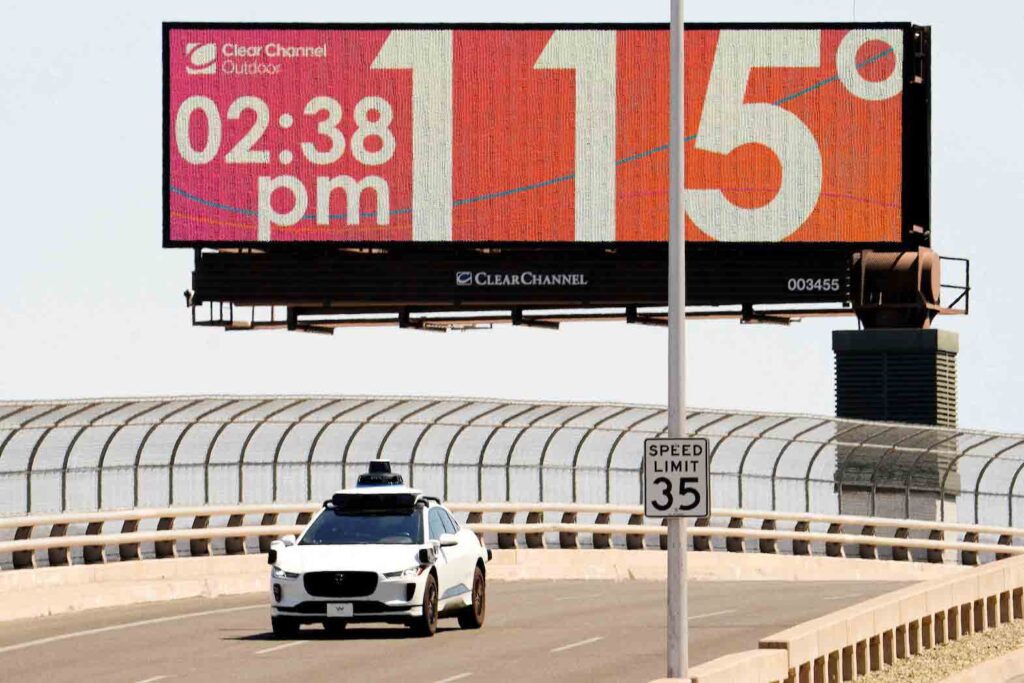Factbox: U.S. hit by blazing heat, smoky air, tropical storm all at once

A Waymo self-driving car drives on Seventh Street as the temperature of 115 degrees is displayed on a digital billboard in downtown Phoenix, Arizona, U.S. July 17, 2023. Phoenix hit 114F (45.5C) on July 17, matching a historic record of 18 straight days over 110F with the forecast showing the record likely to extend for at least another week. Rob Schumacher/USA Today Network via REUTERS.
The United States is experiencing with a range of unusual weather, from a tropical storm in Hawaii to record-breaking heat across its Sun Belt states and poor air quality in many areas as smoke from Canadian wildfires wafts across the border.
As the United States and China, the world’s biggest polluters, tried to reach agreement to cut carbon emissions, Americans experienced a sampler of the extreme weather events that scientists say are likely to become more commonplace under fossil fuel-driven climate change.
Here are some of the notable weather phenomena striking the United States on Wednesday:
HEATWAVE BREAKS ARIZONA RECORD
A massive heat dome parked over the southern and western United States is keeping tens of millions of Americans under extreme heat advisories. The city of Phoenix, Arizona, was on track Tuesday to exceed 110 degrees F (43 C) for the 19th day in a row, breaking its all-time record of 18 straight days over 110, according to forecasters.
Arizona’s largest utility reported that electricity demand was at an all-time high of 8,191 megawatts (MW) on July 15, mirroring trends in Texas. Central Texas, an area stretching from San Antonio north to Dallas, is forecast to reach 105 degrees or higher over the next two days.
The hottest spot in the United States on Tuesday is expected to be Death Valley, California, where temperatures at the visitors center at Death Valley National Park are expected to reach 122 degrees F (50 C). The all-time high for Death Valley is 134 degrees, which is also the hottest temperature ever recorded on the Earth’s surface.
POOR AIR QUALITY
Smoke from Canadian wildfires is still drifting across the United States, causing unhealthy air quality on Tuesday in areas as far-flung as Yosemite National Park in California; Conway, New Hampshire; and – perhaps fittingly – the Great Smoky Mountains National Park in Tennessee, according to the AirNow.gov website, which tracks pollution.
You may like: Unhealthy air quality lingers across US from drifting Canadian wildfire smoke
Winds about 10,000 to 15,000 feet above the ground and other weather patterns can move the smoke 500 miles a day, dispersing it widely over the country, said Stan Benjamin, senior research associate at the Cooperative Institute for Research in Environmental Sciences and National Oceanic and Atmospheric Administration.
“If you have the right kind of weather pattern, you can get this transport of the smoke,” Benjamin said.
TROPICAL STORMS AND FLOODS
Hawaii’s Big Island was under a tropical storm warning early Tuesday morning as it braced for Tropical Storm Calvin, expected to bring as much as 8 inches of rain and wind gusts of 40 mph, the National Weather Service (NWS) said.
Nearly 5,000 miles to the northeast, in Vermont, a flood watch was in effect for central parts of the state including the capital, Montpelier, that were inundated by high water after torrential rainfall last week.
Thunderstorm activity on Tuesday afternoon could bring 1 to 2 more inches of rain per hour to the area, where soil conditions are already saturated, the NWS said, raising the risk of more flash flooding.

